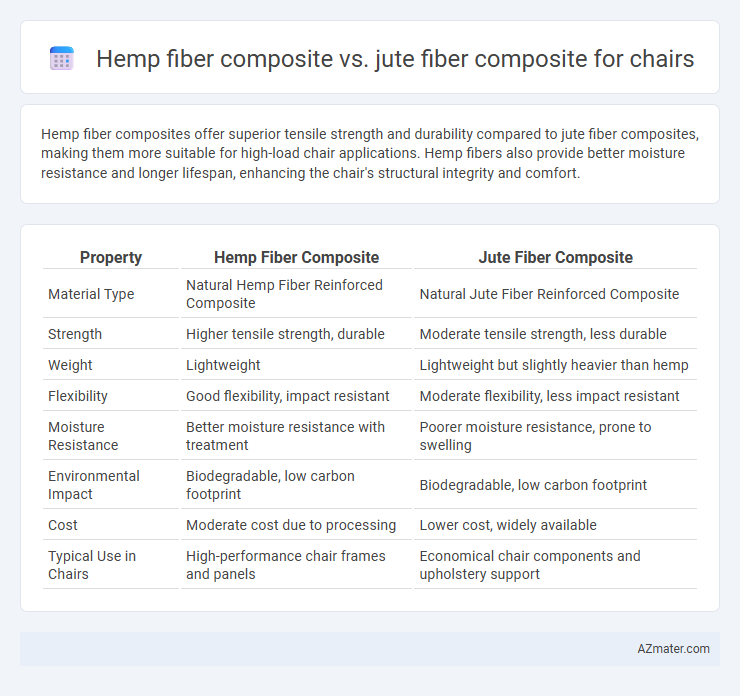Hemp fiber composites offer superior tensile strength and durability compared to jute fiber composites, making them more suitable for high-load chair applications. Hemp fibers also provide better moisture resistance and longer lifespan, enhancing the chair's structural integrity and comfort.
Table of Comparison
| Property | Hemp Fiber Composite | Jute Fiber Composite |
|---|---|---|
| Material Type | Natural Hemp Fiber Reinforced Composite | Natural Jute Fiber Reinforced Composite |
| Strength | Higher tensile strength, durable | Moderate tensile strength, less durable |
| Weight | Lightweight | Lightweight but slightly heavier than hemp |
| Flexibility | Good flexibility, impact resistant | Moderate flexibility, less impact resistant |
| Moisture Resistance | Better moisture resistance with treatment | Poorer moisture resistance, prone to swelling |
| Environmental Impact | Biodegradable, low carbon footprint | Biodegradable, low carbon footprint |
| Cost | Moderate cost due to processing | Lower cost, widely available |
| Typical Use in Chairs | High-performance chair frames and panels | Economical chair components and upholstery support |
Introduction to Natural Fiber Composites in Furniture
Natural fiber composites, such as hemp fiber and jute fiber composites, offer sustainable alternatives in furniture manufacturing, especially for chairs. Hemp fiber composites provide superior strength, durability, and resistance to moisture compared to jute composites, making them ideal for high-load and long-term use applications in seating. Jute fiber composites remain cost-effective and lightweight with good aesthetic appeal, often preferred for environmentally friendly furniture designs emphasizing natural texture and appearance.
Overview of Hemp Fiber and Jute Fiber Properties
Hemp fiber composites offer superior tensile strength and durability compared to jute fiber composites, making them ideal for high-load applications like chairs. Hemp fibers exhibit higher moisture resistance and better thermal stability, which enhances the longevity and structural integrity of furniture. Jute fibers, while more cost-effective and biodegradable, have lower tensile strength and are more susceptible to moisture absorption, limiting their use in long-term furniture applications.
Mechanical Strength Comparison: Hemp vs Jute in Chair Applications
Hemp fiber composites exhibit higher tensile strength and stiffness compared to jute fiber composites, making them more suitable for chair applications requiring enhanced durability and load-bearing capacity. The superior mechanical properties of hemp fibers contribute to improved impact resistance and dimensional stability in chair frames. Jute fiber composites, while more cost-effective and biodegradable, typically offer lower strength and rigidity, limiting their use in high-performance furniture designs.
Environmental Impact and Sustainability of Hemp and Jute
Hemp fiber composites demonstrate superior environmental benefits over jute fiber composites due to their faster growth rate, higher carbon sequestration capacity, and lower pesticide requirements, making them a more sustainable choice for chair manufacturing. The biodegradability and low energy consumption during processing of hemp fibers contribute to reduced ecological footprints compared to jute fibers, which typically require more intensive agricultural inputs and land use. Choosing hemp fiber composites supports circular economy principles by enhancing resource efficiency and minimizing environmental degradation associated with traditional materials.
Processing Techniques for Hemp and Jute Fiber Composites
Hemp fiber composites for chairs involve processes like decortication, retting, and alkaline treatment to enhance fiber-matrix adhesion and mechanical strength. Jute fiber composites require moisture retting and softening treatments to improve flexibility, followed by surface modification methods such as silane coupling to optimize composite bonding. Both fibers benefit from compression molding or resin transfer molding to ensure uniform distribution and enhanced durability in chair manufacturing.
Durability and Longevity in Chair Manufacturing
Hemp fiber composites exhibit superior durability and longevity in chair manufacturing due to their high tensile strength and resistance to microbial degradation. Compared to jute fiber composites, hemp fibers provide enhanced structural stability and moisture resistance, resulting in chairs that maintain integrity under prolonged use. The naturally robust lignin content in hemp fibers also contributes to improved wear resistance, making them ideal for long-lasting furniture applications.
Aesthetic and Design Flexibility: Hemp vs Jute Composites
Hemp fiber composites offer superior aesthetic appeal with a smoother texture and more consistent color, enhancing modern chair designs. Jute fiber composites display a coarser texture and natural earthy tones, lending themselves well to rustic and traditional styles. Design flexibility in hemp composites is higher due to their greater strength-to-weight ratio, allowing for more intricate and durable chair structures.
Cost Analysis: Hemp Fiber vs Jute Fiber Composites
Hemp fiber composites generally exhibit higher material costs compared to jute fiber composites due to more intensive processing and cultivation requirements, impacting the overall manufacturing expense for chairs. However, hemp fibers offer superior durability and strength, potentially reducing long-term replacement and maintenance costs in chair applications. Jute fiber composites present a more economical option upfront, with faster availability and lower raw material prices, but may compromise slightly on longevity and mechanical performance.
User Comfort and Ergonomics in Composite Chairs
Hemp fiber composite offers superior breathability and cushioning compared to jute fiber composite, enhancing user comfort during prolonged chair use. Its higher tensile strength and natural flexibility contribute to better ergonomic support by adapting to body contours and reducing pressure points. Jute fiber composites, while durable, tend to be stiffer and less resilient, potentially compromising comfort and ergonomic effectiveness in composite chair designs.
Future Trends and Innovations in Natural Fiber Furniture
Hemp fiber composites demonstrate superior strength-to-weight ratios and UV resistance compared to jute fiber composites, making them increasingly favored for durable chair manufacturing. Innovations such as bio-based resins and nanocellulose reinforcement are enhancing the mechanical properties and sustainability of hemp fiber composites in furniture applications. Future trends indicate a shift towards hybrid composites combining hemp with recycled materials to optimize performance and environmental impact in natural fiber chair designs.

Infographic: Hemp fiber composite vs Jute fiber composite for Chair
 azmater.com
azmater.com